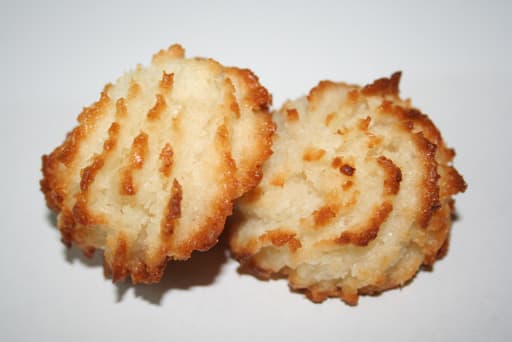
In the weeks before Passover, which begins this year at sundown on April 8th, I start to think about getting my home ready for the holiday and about the first Seder.
Who will come? Because of space considerations and growing families it is my husband’s side one year, my side the next.
What will I serve for dinner? We tend to prefer a more modern approach to the table, but always have a couple of old-fashioned, traditional dishes too.
And the always-important question – what’s for dessert? Dessert can be an issue for people who like cake and pie and all sorts of other treats made with forbidden chometz.
Whatever else I choose, the one confection that we always have is macaroons. They are such favorites around here that for our family it would be unthinkable not to have them at our Seder and throughout the holiday. Unfortunately, no one in my family likes the ones that come in a can, which are available everywhere and now come in all sorts of flavors that were unimaginable when I was growing up (Rocky Road? Toffee Crunch?). So I make my own.
How and why macaroons became a Passover specialty is anyone’s guess. According to many historians, an Italian baker invented the cookies in medieval times. The name comes from a Neapolitan word, maccarone, which means “fine paste”. During the Renaissance, the recipe found its way to France (by way of Catherine DeMedici’s chef), where the cookies became immensely popular. The ones most highly prized came from Nancy, France, in the region of Lorraine, where French Catholic nuns perfected the recipe. When convents were closed during the French Revolution, two nuns of Sainte Thérèse d’Avila, a Carmelite order, continued to bake macaroons in a commercial bakery in Nancy in order to provide for themselves (a street in the town, still renowned for its macaroons, is named for them).
Most likely, Italian or French Jews, early on, realized that macaroons made without flour or leavening, would be perfect for Passover.
And so they are. They are also incredibly easy to make. The simplest versions contain just ground nuts, sugar and egg whites. The original recipe called for almonds, but you can switch to hazelnuts, pecans, walnuts or pistachios.
Somewhere along the historical culinary path, some chef or home cook added shredded coconut to the macaroon recipe and after a while came recipes for coconut macaroons without any nuts at all. In our house I serve both kinds.
The perfect macaroon is crispy on the outside but soft and chewy inside. They’re best the day you make them but I find they last for a few days in an airtight plastic container.
The three macaroon recipes here are our family favorites. You may have seen recipes for macaroons that call for blanched almonds. I don’t bother blanching the nuts; the taste is so close that no one will notice the difference. Macaroons are easy to “enhance” should you desire. You can add all sorts of seasonings and flavorings from spices (cinnamon and ginger, for example) to freshly grated citrus peels to chocolate chips, chopped dried fruit and even chunks of toffee. I’ve made a few suggestions on variations in the first recipe for The Easiest Homemade Coconut Macaroons in the World (they are!). I’ve also included a recipe for a rich and creamy cheesecake that has a macaroon crust. It’s a good choice for dessert after a fish or dairy meal and you can use leftover, not-at-their-prime macaroons.

Ronnie Fein has been a freelance food and lifestyle writer since 1980. She currently writes regular features for the food and community sections of daily newspapers and has written articles for Newsday, Cook’s Illustrated, Consumer’s Digest, Connecticut magazine, and many other publications. She operates the Ronnie Fein School of Creative Cooking in Stamford, Connecticut and is the author of three cookbooks, the most recent is Hip Kosher (DaCapo, 2008).
The words of this author reflect his/her own opinions and do not necessarily represent the official position of the Orthodox Union.

